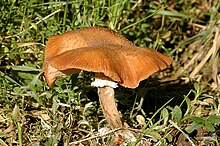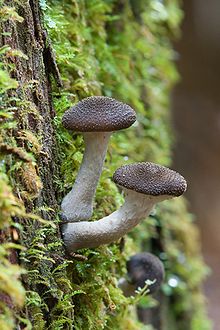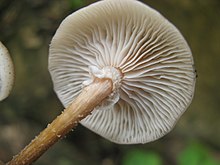
Armillaria is a genus of fungi commonly known as honey mushrooms. First treated by Elias Magnus Fries in 1821, and later assigned generic rank by Friedrich Staude in 1857,[1] Armillaria is classified in the family Physalacriaceae of the Agaricales, the gilled mushrooms.[2] The majority of species in Armillaria are saprotrophic and live mainly on dead wood, but some are parasites that can cause root and butt rot in over 600 species of woody plants.[3] Some Armillaria species form mycorrhizae with orchids;[4] others, such as A. gallica, A. mellea, and A. tabescens, are bioluminescent.[5]
Armillaria species form fleshy, white-spored mushrooms with a cottony or membranous veil that typically forms a distinct annulus on the stem. The fruit bodies usually occur in autumn in large clusters at the base of the stem or roots. Armillaria species can produce rhizomorphs—rootlike aggregations of hyphae—that can form massive, long-lasting underground networks. The growth of the rhizomorph networks allows for tree-to-tree spread of the fungus even when direct contact between diseased and healthy plants is not possible.[6]
The genus once served as a wastebasket taxon for many agaric mushrooms with a white spore print, gills attached to the stem, and an annulus. Due largely to differing interpretations on the limits of the genus, over 270 species and varieties have been placed in Armillaria or its synonym Armillariella. A comprehensive 1995 study by Tom Volk and Harold Burdsall evaluated all of the epithets that have been used in Armillaria or Armillariella. They determined that about 40 species belong to Armillaria sensu stricto (in the strict sense); the remaining names belong to species that are distributed among 43 other modern fungal genera.[7]
Many species are difficult or impossible to distinguish from each other using observable characteristics; laboratory incompatibility tests are often used on pure cultures to reliably determine species. Because of the difficulties posed by routine species identification, the use of DNA sequencing and phylogenetic approaches has become a standard method to help clarify relationships between species. Species differ in their geographical distribution and ecological position, host specificity, microscopic and macroscopic features, and also in their aggressiveness in colonizing wood hosts. The following list of Armillaria species is based on the taxonomic overviews provided by Volk and Burdsall in 1995,[8] David Pegler in 2000,[9] and reports of new species that have been published since then.[10][11][12]
Species[edit]
- Key to the table of species below
| Image | Photo of the Armillaria species. |
|---|---|
| Name | The binomial name of the Armillaria species. |
| Authority | The author citation—the person who first described the species using an available scientific name, eventually combined with the one who placed it in Armillaria, and using standardized abbreviations. |
| Year | The year in which the species was named, or transferred to the genus Armillaria. Where the actual year of publication (as defined for the purpose of priority) differs from the date given in the material, the latter date is given in quotes. |
| Distribution | The distribution of the species; unless otherwise indicated, this information is obtained from Volk and Burdsall (1995), and Pegler (2000). |







| Image | Name | Authority | Year | Distribution |
|---|---|---|---|---|
| Armillaria affinis | (Singer) T.J.Volk & Burds.[13] | 1995 |
| |
| Armillaria altimontana | Brazee, B.Ortiz, Banik & D.L.Lindner.[12] | 2012 | Western North America | |
| Armillaria apalosclera | (Berk.) A.Chandra & Watl.[14] | 1982 ("1981") |
Asia | |

|
Armillaria borealis | Marxm. & Korhonen[15] | 1982 | Eurasia[16] |
| Armillaria calvescens | Bérubé & Dessur.[17] | 1989 | Eastern North America | |
| Armillaria camerunensis | (Henn.) Courtec.[18] | 1995 | Africa | |

|
Armillaria cepistipes[N 1] | Velen.[19] | 1920 |
|
| Armillaria duplicata | (Berk.) Sacc.[21] | 1887 | India | |

|
Armillaria ectypa | (Fr.) Lamoure[22] | 1965 | Europe |
| Armillaria fellea | (Hongo) Kile & Watling[23] | 1983 | Australia | |
| Armillaria fumosa | Kile & Watling[23] | 1983 | Australia | |

|
Armillaria fuscipes | Petch[24] | 1909 |
|

|
Armillaria gallica | Marxm. & Romagn.[26] | 1987 | |

|
Armillaria gemina | Bérubé & Dessur.[17] | 1989 | Eastern North America[17] |
| Armillaria griseomellea | (Singer) Kile & Watling[23] | 1983 | North and South America[27] | |
| Armillaria heimii[N 2] | Pegler[31] | 1977 | Africa | |

|
Armillaria hinnulea | Kile & Watling[23] | 1983 | Australasia |
| Armillaria jezoensis | J.Y.Cha & Igarashi[32] | 1994 | Japan | |

|
Armillaria limonea | (G.Stev.) Boesew.[33] | 1977 |
|

|
Armillaria luteobubalina[N 3] | Watling & Kile[34] | 1978 |
|

|
Armillaria mellea | (Vahl) P.Kumm.[36] | 1871 |
|
| Armillaria melleorubens | (Berk. & M.A.Curtis) Sacc.[21] | 1887 | North and Central America | |

|
Armillaria mexicana | Elías-Román et al.[37] | 2018 | Mexico |
| Armillaria montagnei[N 3] | (Singer) Herink[38] | 1973 |
| |

|
Armillaria nabsnona | T.J.Volk & Burds.[39] | 1996 |
|

|
Armillaria novae-zelandiae | (G.Stev.) Boesew.[33] | 1973 |
|
| Armillaria omnituens | (Berk.) Sacc.[21] | 1887 | India | |
| Armillaria pallidula | Kile & Watling[40] | 1988 | Australia | |
| Armillaria paulensis | Capelari[10] | 2008 | South America[10] | |
| Armillaria pelliculata | Beeli[29] | 1927 | Africa | |
| Armillaria procera | Speg.[41] | 1889 | South America | |

|
Armillaria puiggarii | Speg.[41] | 1889 | South America |

|
Armillaria sinapina | Bérubé & Dessur.[42] | 1988 | |
| Armillaria singula | J.Y.Cha & Igarashi[32] | 1994 |
| |
| Armillaria socialis | (DC.) Fayod[43] | 1889 |
| |

|
Armillaria solidipes, popularly known as Armillaria ostoyae [N 4] | Peck[46] | 1900 | |
| Armillaria sparrei | (Singer) Herink[38] | 1973 | North and South America | |

|
Armillaria tabescens | (Scop.) Emel[47] | 1921 |
|
| Armillaria tigrensis | (Singer) T.J.Volk & Burds.[48] | 1983 | South America | |
| Armillaria umbrinobrunnea | (Singer) Pildain & Rajchenb.[11] | 2010 | South America | |
| Armillaria viridiflava | (Singer) T.J.Volk & Burds.[49] | 1995 |
| |
| Armillaria yungensis | (Singer) Herink[38] | 1973 | South America |
Notes[edit]
- ^ The original spelling of the species name was cepaestipes.[19]
- ^ This was a nomen novum for Robert Heim's Clitocybe elegans,[28] as Maurice Beeli had described Armillaria elegans[29] in 1927 (that species is now placed in Cystodermella).[30]
- ^ a b A. montagnei and A. luteobubalina may represent the same species. If this is so, its correct epithet would be montagnei.[11]
- ^ This species was known as Armillaria ostoyae until a 2008 publication revealed that Charles Horton Peck had described the taxon under a different name in 1900.[45]
References[edit]
- ^ Volk and Burdsall (1995), p. 8.
- ^ Kirk PM, Cannon PF, Minter DW, Stalpers JA (2008). Dictionary of the Fungi (10th ed.). Wallingford, UK: CABI. p. 49. ISBN 978-0-85199-826-8.
- ^ Tainter FH, Baker FA (1996). Principles of Forest Pathology. Chichester: Wiley. p. 424. ISBN 978-0-471-12952-3.
- ^ Cha JY, Igarashi T (1995). "Armillaria species associated with Gastrodia elata in Japan". European Journal of Forest Pathology. 25 (6–7): 319–26. doi:10.1111/j.1439-0329.1995.tb01347.x.
- ^ Mihail JD, Bruhn JN (2007). "Dynamics of bioluminescence by Armillaria gallica, A. mellea and A. tabescens". Mycologia. 99 (3): 341–50. doi:10.3852/mycologia.99.3.341. PMID 17883025.
- ^ Mihai JD, Bruhn JN (2005). "Foraging behaviour of Armillaria rhizomorph systems". Mycological Research. 109 (11): 1195–207. doi:10.1017/S0953756205003606. PMID 16279413.
- ^ Volk and Burdsall (1995), p. 6.
- ^ Volk and Burdsall (1995).
- ^ Pegler DN. (2000). "Taxonomy, nomenclature and description of Armillaria". In Fox RTV (ed.). Armillaria Root Rot: Biology and Control of Honey Fungus. Andover, Hants, UK: Intercept. pp. 81–93. ISBN 978-1-898298-64-9.
- ^ a b c Lima MLA, Asai T, Capelari M (2008). "Armillaria paulensis: a new South American species". Mycological Research. 112 (9): 1122–28. doi:10.1016/j.mycres.2008.03.006. PMID 18692378.
- ^ a b c Pildain MB, Coetzee MPA, Wingfield BD, Wingfield MJ, Rajchenberg M (2010). "Taxonomy of Armillaria in the Patagonian forests of Argentina" (PDF). Mycologia. 102 (2): 392–403. doi:10.3852/09-105. hdl:2263/14133. PMID 20361506. S2CID 40869544. Retrieved 2010-03-21. [permanent dead link]
- ^ a b Brazee NJ, Ortiz-Santana B, Banik MT, Lindner DL (2012). "Armillaria altimontana, a new species from the western interior of North America". Mycologia. 104 (5): 1200–5. doi:10.3852/11-409. PMID 22505437. S2CID 24220972.
- ^ Volk and Burdsall (1995), p. 24.
- ^ Chandra A, Watling R (1981). "Studies in Indian Armillaria (Fries per Fries) Staude (Basidiomycotina)". Kavaka. 10: 63–84.
- ^ Marxmüller H. (1982). "Étude morphologique des Armillaria ss.str. à anneau". Bulletin de la Société Mycologique de France (in French). 98 (1): 87–124.
- ^ a b c d e f Qin GF, Zhao J, Korhonen K (2007). "A study on intersterility groups of Armillaria in China". Mycologia. 99 (3): 430–41. doi:10.3852/mycologia.99.3.430. PMID 17883035.
- ^ a b c Bérubé JA, Dessureault M (1989). "Morphological studies of the Armillaria mellea complex: Two new species, A. gemina and A. calvescens". Mycologia. 81 (2): 216–25. doi:10.2307/3759703. JSTOR 3759703. Archived from the original on 2012-12-24. Retrieved 2011-02-01.
- ^ Courtecuisse R. (1995). "Taxonomy of some fungi used by the Songola people (Zaïre)" (PDF). African Study Monographs. 16 (1): 45–60.
- ^ a b Velenovský J. (1920). České Houby (in Czech). Vol. 2. Prague, Czechoslovakia: České Botanické Společnosti. p. 283.
- ^ a b c d e Ota Y, Sotome K, Hasegawa E (2009). "Seven Armillaria species identified from Hokkaido Island, northern Japan". Mycoscience. 50 (6): 442–47. doi:10.1007/s10267-009-0505-1. S2CID 85249295.
- ^ a b c Saccardo PA. (1887). "Sylloge Hymenomycetum, Vol. I. Agaricineae". Sylloge Fungorum (in Latin). 5: 83–84.
- ^ Lamoure D. (1965). "Charactères mycéliens et position taxinomique de Clitocybe ectypa (Fr.) F.Moreau". Comptes Rendus Hebdomadaires des Séances de l'Académie des Sciences (in French). 260 (4): 4561–63.
- ^ a b c d Kile GA, Watling R (1983). "Armillaria species from southeastern Australia". Transactions of the British Mycological Society. 81 (1): 129–40. doi:10.1016/S0007-1536(83)80212-5.
- ^ Petch T. (1909). "New Ceylon fungi". Annals of the Royal Botanic Gardens Peradeniya. 4: 299–307.
- ^ Wingfield BD, Maphosa L, Coetzee MPA, Mwenje E, Wingfield MJ (2009). "Characterisation of Zimbabwean Armillaria using IGS-1 sequences and AFLP analysis" (PDF). Fungal Diversity. 34: 187–96.
- ^ Marxmüller H. (1987). "Quelques remarques complémentaires sur les Armillaires annelées". Bulletin Trimestriel de la Société Mycologique de France (in French). 103 (2): 137–56.
- ^ Pildain MB, Coetzee MPA, Rajchenberg M, Petersen RH, Wingfield MJ, Wingfield BD (2009). "Molecular phylogeny of Armillaria from the Patagonian Andes". Mycological Progress. 8 (3): 181–94. Bibcode:2009MycPr...8..181P. doi:10.1007/s11557-009-0590-8. S2CID 24112504.
- ^ Heim R. (1963). "L'Armillariella elegans Heim". Revue de Mycologie (in French). 28: 85–94.
- ^ a b Beeli M. (1927). "Contribution à l'étude de la flore mycologique du Congo II". Bulletin de la Société Royale de Botanique de Belgique (in French). 59: 101–12.
- ^ Harmaja H. (2002). "Amylolepiota, Clavicybe and Cystodermella, new genera of Agaricales". Karstenia. 42 (2): 39–48. doi:10.29203/ka.2002.386.
- ^ Pegler DN. (1977). A preliminary Agaric flora of East Africa. "Kew Bulletin, additional Series", 6. London: Royal Botanic Gardens, Kew. p. 92. ISBN 978-0-11-241101-7.
- ^ a b Cha JY, Sung JM, Igarashi T (1994). "Biological species and morphological characteristics of Armillaria mellea complex in Hokkaido: A. sinapina and two new species, A. jezoensis and A. singula". Mycoscience. 35 (1): 39–47. doi:10.1007/BF02268526. S2CID 83496798.
- ^ a b Boesewinkel HJ. (1977). "New plant disease records in New Zealand: records in the period 1969–76". New Zealand Journal of Agricultural Research. 20 (4): 585. Bibcode:1977NZJAR..20..583B. doi:10.1080/00288233.1977.10427376.
- ^ Podger FD, Kile GA, Watling R, Fryer J (1978). "Spread and effects of Armillaria luteobubalina sp. nov. in an Australian Eucalyptus regnans plantation". Transactions of the British Mycological Society. 71 (1): 77–87. doi:10.1016/S0007-1536(78)80009-6.
- ^ Coetzee MPA, Wingfield BD, Bloomer P, Ridley GS, Wingfield MJ (2003). "Molecular identification and phylogeny of Armillaria isolates from South America and Indo-Malaysia". Mycologia. 95 (2): 285–93. doi:10.2307/3762039. JSTOR 3762039. PMID 21156614. Archived from the original on 2012-12-24. Retrieved 2011-02-01.
- ^ Kummer P. (1871). Der Führer in die Pilzkunde (in German). Zerbst. p. 134.
- ^ "Index Fungorum - Names Record". www.indexfungorum.org. Retrieved 2023-11-26.
- ^ a b c Herink J. (1973). "Taxonomie václavky obecné – Armillaria mellea (Vahl ex Fr.) Kumm". In Hasek J (ed.). Sympozium o Václavce Obecné Armillaria mellea (Vahl ex Fr.) Kumm (in Czech). Brno, Czechoslovakia: Vysoká Skola Zemĕdĕlská v Brné. pp. 21–48.
- ^ Volk TJ, Burdsall HH, Banik MT (1995). "Armillaria nabsnona, a new species from western North America". Mycologia. 88 (3): 484–91. doi:10.2307/3760888. JSTOR 3760888. S2CID 85098372.
- ^ Kile GA, Watling R (1988). "Identification and occurrence of Australian Armillaria species, including Armillaria pallidula sp. nov and comparative studies between them and non-Australian tropical and Indian Armillaria". Transactions of the British Mycological Society. 91 (2): 305–15. doi:10.1016/S0007-1536(88)80219-5.
- ^ a b Spegazzine C. (1889). "Fungi Puiggariani. Pugillus 1". Boletín, Academia Nacional de Ciencias, Córdoba (in Latin). 11 (4): 381–622.
- ^ Bérubé JA, Dessureault M (1988). "Morphological characterization of Armillaria ostoyae and Armillaria sinapina sp. nov". Canadian Journal of Botany. 66 (10): 2027–34. doi:10.1139/b88-277.
- ^ Fayod MV. (1889). "Prodrome d'une histoire naturelle des Agaricinés". Annales des Sciences Naturelles, Botanique. Série 7 (in French). 9: 181–411. Archived from the original on 2011-09-30. Retrieved 2011-02-01.
- ^ Antonín V, Jankovsky L, Lochman J, Tomšovsky M (2006). "Armillaria socialis – morphological-anatomical and ecological characteristics, pathology, distribution in the Czech Republic and Europe" (PDF). Czech Mycology. 58 (3–4): 209–24. doi:10.33585/cmy.58305. [permanent dead link]
- ^ Burdsall HH, Volk TJ (2008). "Armillaria solidipes, an older name for the fungus called Armillaria ostoyae" (PDF). North American Fungi. 3 (7): 261–67. doi:10.2509/naf2008.003.00717. Archived from the original (PDF) on 2011-07-21.
- ^ Peck CH. (1900). "New species of Fungi". Bulletin of the Torrey Botanical Club. 27 (12): 609–13. doi:10.2307/2477998. JSTOR 2477998. (subscription required)
- ^ Emel (1921). Le Genre Armillaria, Fr., Sa Suppression de la Systématique Botanique (Thesis) (in French). Strasbourg, France: Faculté de Pharmacie, Université de Strasbourg. OCLC 32072244.
- ^ Volk and Burdsall (1995), p. 115.
- ^ Volk and Burdsall (1995), p. 119.
Cited literature[edit]
- Volk TJ, Burdsall HH Jr (1995). A nomenclatural study of Armillaria and Armillariella species (Basidiomycotina, Tricholomataceae) (PDF). Synopsis Fungorum. Vol. 8. Førde, Norway: Eko-trykk A/S. p. 121. ISBN 978-82-90724-14-1.